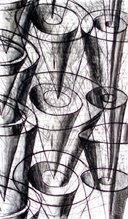At present, I am working on a project called Demonstrations. It is a collaboration between myself and professional mathematicians. Our goal is to bring research mathematics to the general public. In order to do so, I have invited working mathematicians to introduce me to their theorems. Under their guidance, I work to understand their ideas and throughout the process I will create art works that integrate both the mathematical and the artistic. The fruits of these collaborations will be exhibited at the Shift Collaborative Studio in May 2007.
I call these works dimostrazione, which was Leonardo da Vinci's term for the kind of graphic "demonstrations" he was making in Milan between 1490 and 1495 to accompany his writings. It was during this period that Leonardo emerged as the great writer of treatises wherein we find the precursor to modern scientific illustration. My drawings and paintings are made in that da Vincian spirit of pedagogy that has arisen naturally as a result of my teaching college math; in the classroom, I continue to discover the importance and sometimes precedence of illustration over the written word.
In general, my work presents ideas from many areas of math ranging from the classical curriculum to the latest developments in research. For example, a couple drawings are demonstrations of how different quadric surfaces are related by variable parameters. Thus, for example, if I vary a certain coefficient "a" continuously from a > 0 to a < 0, I can move from a paraboloid to a cylinder over a parabola to a hyperbolic paraboloid. These parametrizations from calculus generalize to current research in moduli spaces.
It is one of my intentions that future mathematical treatises be so well illustrated that the function of the text is to explain the pictures. To this end, each of my works has an accompanying mathematical text describing the ideas demonstrated therein. In this way, viewers can experience both the visual and the textual as a duality of cognitive perception-it is the synthesis of the two that leads to a complete understanding of each individual work.
Though my drawings and paintings often start as strict mathematical illustrations, as I work and rework them, they become demonstrations that go beyond their mathematical origins and realize their own unique idiosyncratic purpose.
Subscribe to:
Post Comments (Atom)

No comments:
Post a Comment